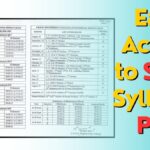Are you looking for the concept of derivatives with implicit and explicit differentiation functions? If yes, you have come to the right place.
The derivative is a fundamental solution to the problem in calculus and differential equations (DEs). In Mathematics, the derivative is primarily used when there is some varying quantity, and the rate of change is not constant.
In this article, the basic definition with formulas and with the help of examples topic is explained.
Table of Contents
Concept of Derivatives with Implicit & Explicit Differentiation Functions
Definition of differentiation
The derivative of a function of variable measures the sensitivity to change of the function value (output value) concerning a change in its argument (input value). A fundamental tool derivative in calculus.
The derivative is used to measure the sensitivity to change a function value (output value) concerning changing its arguments (input value). The method of calculating the derivative is known as differentiation and its inverse method is known as integration.
Let’s suppose, to find the derivative of a function x = g(y). It is the quantity of the rate at which the value of x changes concerning the change of the variable y. It is known as the derivative of the function “g”, concerning the variable y.
If an inconsiderable change in y is denoted as dy, then the derivative of x with respect to y is written by dx/dy. Here the derivative of x with respect to y is read as “dx by dy” or “dx over dy”.
The formula of differentiation through the First Principle Method is Lim h→0 [f(x+h) – f(x)]/h
Differentiation of Inverse Functions
There are a few derivatives of inverse trigonometric functions:
- d/dy {sin -1 (y)} = 1 / (1-y²) , y ≠ ± 1
- d/dy {cos -1 (y)} = -1 / (1-y²) , y ≠ ± 1
- d/dy {tan -1 (y)} = 1 / (1+y²)
- d/dy {cot -1 (y)} = -1 / (1+y²)
- d/dy {sec -1 (y)} = 1 / |x| (y²-1) , y ≠ ± 1,0
- d/dy {cosec -1 (y)} = -1 / |x| (y²-1) , y ≠ ± 1,0
Implicit Differentiation Function
The implicit function is a function calculated for the differentiation functions including the variables, which cannot be simply expressed in the form of x= f(y). The function of the form g(y, x)=0, where the dependent variable ‘x’ and the independent variable ‘y’ cannot be isolated to represent a function of the form x = f(y).
In mathematics, some equations in y and x do not explicitly calculate x as a function y and cannot be simply manipulated to solve for x in terms of y, even though such a function may exist. The simpler implicit differentiation function allows finding the derivative of x with respect to y without having to calculate the given equation for x.
Because the differentiation of a function x = f( y) is itself a function x′ = f′(y), we can take the derivative of f (y), which is simply referred to as the second derivative of f(y) and written f“(y) or f 2 (y). This differentiation process can be continued to calculate the third, fourth, and successive derivatives of f(y), which are known as higher-order derivatives of f(y).
For instance
- x² + y² + 4xy + 7 = 0
- x + Sinxy – y = 0
The basic rule of implicit function is accommodating a better understanding of this function.
- The implicit function cannot be expressed in the form of x = f(y).
- The implicit function is always described as a combination of variables as f(y, x) = 0.
- The implicit function is written both positions of the dependent variable y and independent variable x.
Explicit Differentiation Function
An explicit function is a type of mathematical function that defines the dependent variable y explicitly in terms of the independent variable x. In other words, an explicit function is a function where the output variable can be directly calculated from the input variable using a formula.
For example, the function x = 2y + 3 is an explicit function because x is defined explicitly in terms of y. If we know the value of y, we can calculate the value of x using the formula x = 2y + 3.
A derivative calculator by Allmath is a helpful tool to evaluate the complex problems of explicit differentiation with steps.
Example Section
In this section, with the help of examples, the topic is explained.
Example 1 –
Evaluate the derivative of (x²+6) × (x+1)
Solution:
Step 1:
Let the given function is y
y = (x²+6) × (x+1)
Step 2:
Taking derivative on both sides with respect to x
d/dx (y) = d / dx {(x²+6) × (x+1)}
Step 3:
It is in product form the product rule will be used here to find the derivative
In simple words,
d/dx (y) = (1 st Function as it is) * (Derivative of 2 nd ) + (2 nd Function as it is) * (Derivative of 1 st )
In mathematical form,
d/dx (y) = d/dx (A(x)*B(x)) = A(x) × d/dx (B(x)) + B(x) × d/dx (A(x))
dy /dx = (x²+6) × d/dx (x+1) + (x+1) × d/dx (x²+6)
Step 4:
Here with help of the sum rule and power rule, you can easily calculate the derivative.
dy /dx = (x²+6) × {d/dx (x)+d/dx (1)} + (x+1) × {d/dx (x²) +d/dx (6)}
dy /dx = (x²+6) × (1) + (x+1) × (2x +0}
Step 5:
Now simplify the terms to get your derivative of the given function.
dy /dx = (x²+6) + (x+1) × (2x)
dy /dx = x²+ 6 + 2x² +2x
dy /dx = 3x² + 2x + 6
Example 2 –
Evaluate the derivative of (x²+3) / (x+1)
Solution:
Step 1:
Let the given function is
y = (x²+3) / (x+1)
Step 2:
Taking derivative on both sides with respect to x
d/dx (y) = d / dx {(x²+3) / (x+1)}
Step 3:
It is in the division form the quotient rule will be used here to find the derivative, quotient rule is defined as:
d/dx (u/v) = {d/dx (u) * v – u * d/dx (v)} / (v)²
step 4:
d/dx[x²+3/x+1]
= d/dx[x²+3] * (x+1) – (x²+3) * d/dx[x+1] / (x+1)²
= (d/dx[x²] + d/dx[3]) (x+1) – (x²+3)(d/dx[x] + d/dx[1]) / (x+1)²
= {(2x+0) (x+1) – (x ²+3)(1+0) } / (x+1)²
= -x² + 2x (x+1) – 3 / (x+1)²
Final words
In this article, the basic definition of a derivative and its formula for Implicit and Explicit functions are discussed. Furthermore, with the help of examples, the topic is explained. After a complete understanding of this article, anyone can easily solve the related problem.
If you really liked this article about the concept of derivatives, please share it with those who need it.
Thank you.








